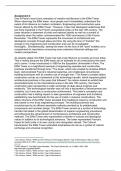Assignment 4
One of Paris's most iconic examples of creative architecture is the Eiffel Tower.
When observing the Eiffel tower, most people won't immediately understand the
extent of its influence on modern civilization. Engineering and construction were
forever altered by the Eiffel Tower.1 However, it also has ideological undertones that
are firmly ingrained in the French sociopolitical milieu of the late 19th century. The
tower became a statement of pride and national identity as well as a symbol of
modernity when the nation commemorated the 100th anniversary of the French
Revolution. The Eiffel Tower represents the movement of architectural and
ideological concepts through place and time. By using the lens of “transfer” this
change in the engineering and construction area can be investigated
thoroughly. Simultaneously, seeing the tower via the lens of the "post" enables us to
comprehend its importance concerning more extensive historical settings and
modern perspectives.
As already stated, the Eiffel Tower has had a big influence on society we know today.
This is mainly because the Eiffel tower set an example for all constructions that were
yet to come.2 It was constructed in 1889 for the Exposition Universelle in Paris. The
Eiffel Tower is a magnificent example of engineering expertise and construction
practices transferred through time.3 The tower, which was created by Gustave Eiffel's
team, demonstrated France's industrial expertise, and challenged conventional
building techniques with its creative use of wrought iron.4 The tower's complex lattice
construction serves as a testament to this technology transfer, which impacted global
architectural practices in the years that followed.5 As nations looked to exhibit their
accomplishments on the international scene in the late 19th century, the tower's
construction also represented a wider exchange of ideas about progress and
modernity. This technological transfer was not only a declaration of advancement and
creativity, but it was also a construction achievement. The tower's conception and
construction had a lasting impact on later generations of engineers and architects,
establishing new benchmarks for the use of metal in massive constructions. The
lattice structure of the Eiffel Tower deviated from traditional masonry construction and
was based on iron truss engineering concepts. The building business was
revolutionized by its efficient assembly methods provided by its prefabricated
components and modular design. The Eiffel Tower served as a symbol of technology
transfer that aided in the global dissemination of superior engineering procedures
and influenced the advancement of contemporary architecture and construction
methods. The Eiffel Tower also represented a transfer of cultural and ideological
values in addition to its technological advances. The tower represented France's
hopes for both pride in its own country and recognition abroad. The Cultural
transmission the Eiffel Tower embodied emphasizes its role as a symbol of cultural
exchange and universal recognition.
1 De Oliveira, Patrick, "Eiffel and the Telling of Technological Stories," Age of Revolutions. May 23, 2022.
Accessed March 22, 2024, https://ageofrevolutions.com/2022/05/23/eiffel-and-the-telling-of-technological-
stories/.
2 Levin, Miriam R, “The Eiffel Tower Revisited,” The French Review 62, no. 6 (1989): 1052–1053,
http://www.jstor.org/stable/394841.
3 De Oliveira, Patrick, "Eiffel and the," Age of Revolutions.
4 De Oliveira, Patrick, "Eiffel and the," Age of Revolutions.
5 De Oliveira, Patrick, "Eiffel and the," Age of Revolutions.





